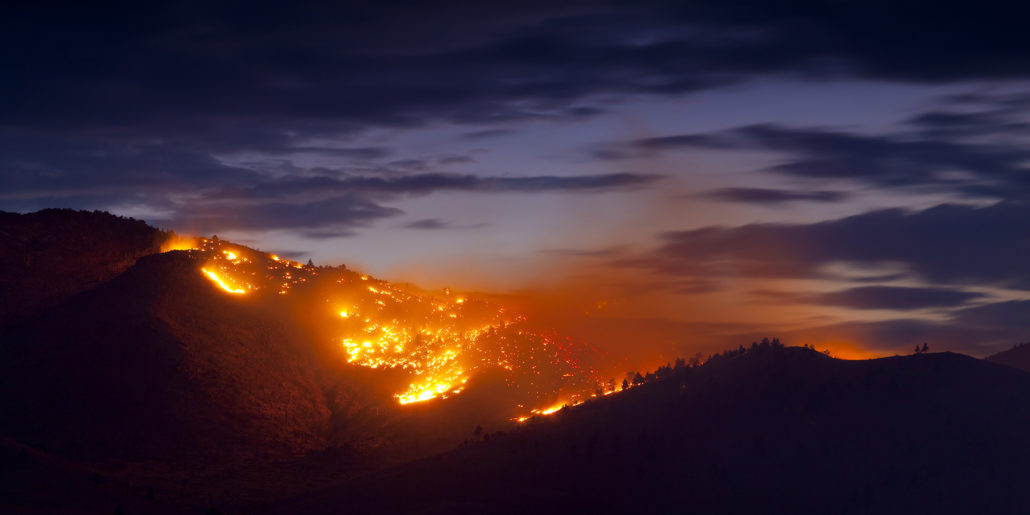Another Wildfire Season – Protect Your Home and Property!
Forest and wildfire season is upon us! Do what you can to ensure your home and property are protected.
Our area is experiencing yet another aggressive wildfire season. It may be a later start than years past, but such a hot dry July and August have left us vulnerable to both natural and human-initiated fire events. As we watch with interest and concern communities and wilderness under immediate threat, you may think there really isn’t anything you can do to protect your home and property against the perils of forest and wildfires.
There are many regions of the province of British Columbia vulnerable to the threat of wildfires. Our West Kootenay communities certainly are!
Did you know? Much of the Canadian landmass is covered in forests – 30 per cent of the total forests of the earth and 10 per cent of what is referred to as forest cover are here in Canada. Just by nature of our forest cover, many Canadian communities are subject to the threat of wildfire.
And that’s not necessarily bad. Forest and wildfires are, in fact, necessary to maintain a healthy forest ecosystem. Fire is vital to forest renewal as it aids in the release of seeds and important nutrients as it reduces the forest canopy overhead to let in essential sunlight to stimulate growth.
But, given climate change and the associated challenges and issues, such as less precipitation and increased temperatures, not to mention the consistent and steady development and infringement of human activity on the surrounding natural world, wildfires become just that much a greater threat to our communities, property, and wilderness.
Natural Resources Canada (NRC) has identified that a whopping 2.5 million hectares per year have been destroyed by forest and wildfires in Canada over the last 30 years. That means a significant cost to land and property as well as significant resources devoted to efforts of fire suppression – $500 million to $1 billion a year!
To keep track of forest and wildfire activity throughout the province and the region, check out the British Columbia interactive wildfire map, for regular updates.
Meantime, as you keep your eye on the wildfire situation in our area, there are steps you can take to protect your home and property in the face of a wildfire threat. Keep in mind though, the steps below help to protect your home against fire, but we always encourage you to heed to the advice and information of local authorities and follow any instructions and restrictions in the event of imminent fire danger. The priority is always, first and foremost, to protect yourself and your loved ones.
Create a home that is as fire-resistant as possible
Here are a variety of things you can do to help make your home or business as forest and wildfire-resistant as possible:
- Siding materials: As you consider the safety of your home, it’s important to know that vinyl and wood and vinyl are not good choices for fire-resistance. Consider instead materials like stucco, metal, brick, concrete, or fibre-cement siding. You may be surprised to know that logs and timbers are actually more fire-resistant than other wood options.
- Roofing material: Wood shakes are just not good when it comes to protecting your home from fire. Wood materials are very combustible and also can leave potentially dangerous cracks that can let in burning embers and debris. Metal and asphalt are much better choices, along with clay and composite rubber tiles.
- Windows: It’s best to replace any single-pane windows with tempered, dual- or multi-paned windows. The extreme heat from a wildfire can actually break single-paned windows. Additionally, you should install metal screening to help reduce radiant exposure and protect your home from burning debris or embers coming through.
- Doors: Make sure all the doors of your home, garage, and any other buildings on your property are fire-rated and have proper seals.
- Chimney: Add a spark arrestor to your chimney. Your fireplace or woodstove can actually be a dangerous source of fire. Sparks and embers can be tossed out on to your roof or into the surrounding trees, shrubs, or brush.
- Balconies and decks: As with siding and roof materials, decking should be made of non-combustible material.
- Gutters and eaves: Buildup and clutter in your gutters can be a vulnerability – easily ignited by sparks and embers.
- Vents: Even small openings can make your home vulnerable to sparks or burning embers. Install fire-rated vents and have them screened over for additional protection.
- Fences: A wood fence can lead flames and fire right to your front door. If you’re able, install a metal gate to separate the wood fence from your home.
- Sheds and outbuildings: Any other structures (garages, guesthouse, workshops, even an outhouse) on your property within 10 metres of your home should follow the same guidelines as with your home.
- Lawn: Keep your lawn, shrubs, trees, and landscaping mowed, trimmed, and well-watered.
Chances are your existing home policy (condo, tenant, farm, commercial, and auto) provides coverage for forest and wildfire.
BUT, if you have any questions about the details of your insurance policy and fire – some kinds of damage can, in fact, be excluded or have limits – CONTACT US!

